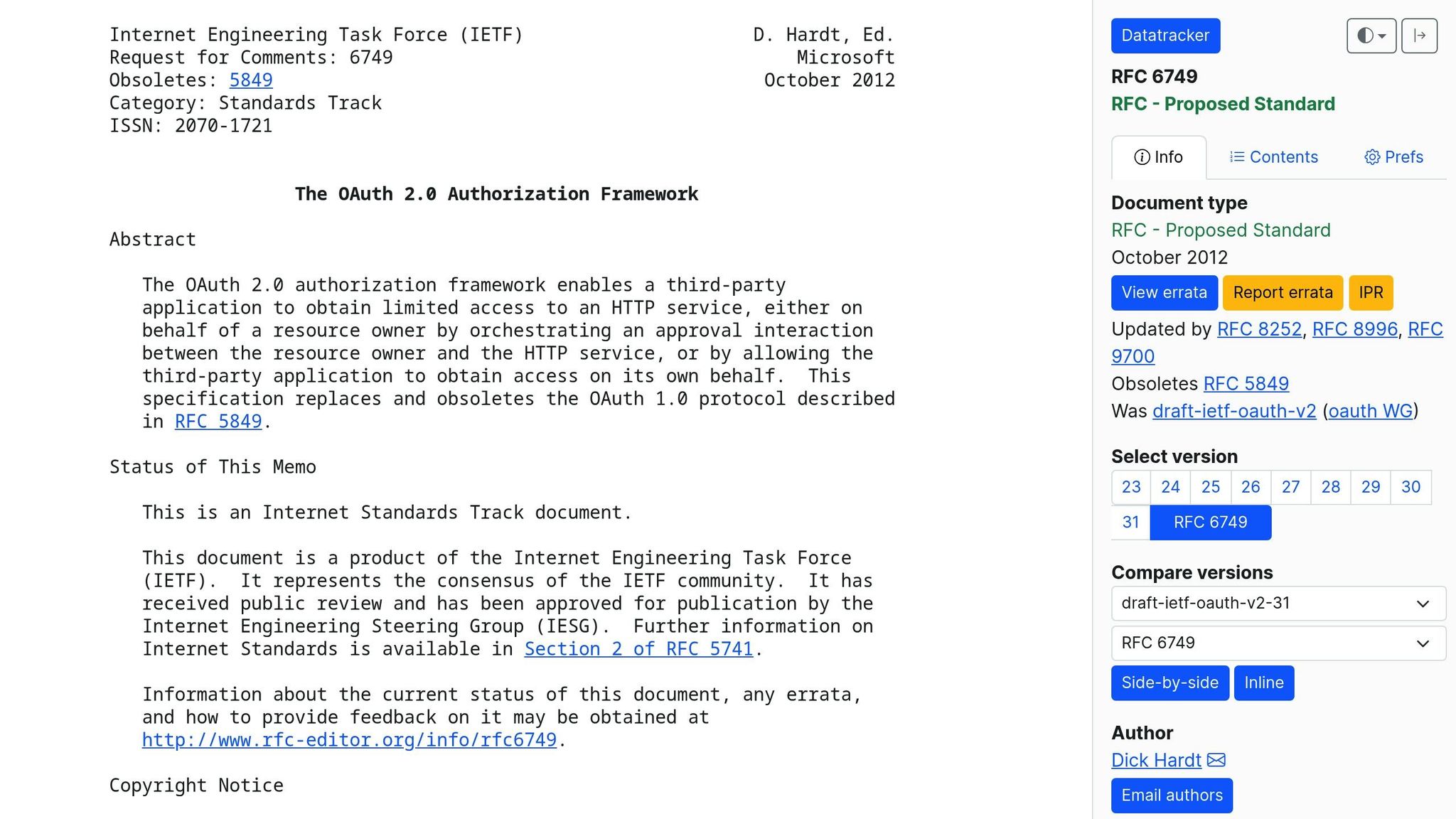ERP APIs are the backbone of modern businesses, handling critical data like finances and customer information. Securing them is non-negotiable. Here's a quick summary of how to protect ERP APIs:
- Authentication & Authorization: Use OAuth 2.0 and OpenID Connect for secure user verification and access control.
- Access Management: Implement Role-Based Access Control (RBAC) to limit user access based on roles.
- Data Encryption: Secure data transmission with TLS/SSL protocols.
- Input Validation: Block harmful inputs through strict data validation rules.
- Traffic Control: Prevent abuse with rate limiting, DDoS protection, and API gateway configurations.
- Security Monitoring: Use real-time monitoring to detect threats and maintain compliance.
- Policies & Documentation: Define clear security rules, enforce them, and maintain detailed records for audits.
These steps ensure your ERP system remains secure, compliant, and reliable. Regular updates, monitoring, and proactive measures are essential to stay ahead of evolving threats.
CIS API Security Guidelines - Achieving end-to-end API security
1. OAuth 2.0 and OpenID Connect Standards

OAuth 2.0 and OpenID Connect help secure ERP APIs by managing authentication and authorization. These protocols protect sensitive business data while allowing safe third-party integrations.
OAuth 2.0 Implementation Essentials
- Token-Based Authentication: Use access tokens with short lifespans (1–2 hours) and refresh tokens for longer sessions.
- Secure Authorization Flows: Apply authorization code flow for web apps and PKCE (Proof Key for Code Exchange) for mobile apps.
- Scope Definition: Define granular API access scopes that match specific ERP functions.
OpenID Connect Features for Added Security
OpenID Connect enhances OAuth 2.0 with identity verification through:
- JWT (JSON Web Tokens) for secure data exchange.
- ID Tokens containing user identity details.
- UserInfo Endpoint for accessing additional user profile information.
Core Security Measures
When setting up OAuth 2.0 and OpenID Connect for ERP systems, keep these key points in mind:
- Token Management: Ensure access tokens expire within 1–2 hours, refresh tokens within 30 days, and implement token revocation endpoints.
- Client Authentication: Use client secrets for confidential clients and PKCE for public clients. Always validate TLS certificates.
- Authorization Server Security: Strengthen security by:
- Adding rate limits on token endpoints.
- Implementing IP-based access controls.
- Logging all authorization requests for auditing.
Best Practices
- Always enable SSL/TLS encryption for OAuth endpoints.
- Use state parameters to guard against CSRF attacks.
- Add nonce values to block replay attacks.
- Store tokens securely using platform-specific secure storage solutions.
- Validate tokens on the resource server.
2. RBAC Access Management
RBAC (Role-Based Access Control) builds on secure authentication methods by tying user access to specific roles within an organization. It ensures users can only access the resources they need to perform their duties, adding an extra layer of security through role-specific restrictions.
Key RBAC Components
In ERP systems, RBAC relies on three main elements:
- User Assignments: Employees are assigned to clearly defined roles.
- Role Permissions: Each role has a predefined set of access rights.
- Access Controls: Permissions are checked before granting access to system resources.
How to Implement RBAC
To set up RBAC in ERP systems effectively, follow these steps:
1. Define a Role Hierarchy
Create a structure that mirrors your organization's departments and responsibilities:
| Role | Scope | Examples |
|---|---|---|
| System Admin | Full System | System configurations, user management |
| Department Manager | Department-wide | Access to reports, managing team members |
| Regular User | Task-specific | Handling transactions, viewing personal data |
| External Partner | Limited | Access to specific APIs or restricted data |
2. Set Detailed Permissions
Assign specific permissions for various actions:
- Read-only: For viewing data.
- Write: For modifying information.
- Execute: For running processes.
- Delete: For authorized data removal.
3. Use Dynamic Access Rules
Add context-based restrictions, such as:
- Time-based access (e.g., during working hours only).
- Location-based permissions (e.g., specific IP ranges).
- Device-based rules (e.g., approved devices only).
- Multi-factor authentication for sensitive actions.
Why RBAC Matters for Security
RBAC adds several layers of protection and efficiency to ERP systems:
- Limits Vulnerabilities: Reduces risk by restricting access to only necessary resources.
- Eases Auditing: Clear role definitions simplify tracking and reviewing access.
- Supports Compliance: Helps meet regulatory requirements with documented access controls.
- Simplifies Management: Streamlines user permissions by using role-based assignments.
Ongoing Maintenance
To keep RBAC effective, regular updates and reviews are crucial:
- Access Reviews: Conduct quarterly audits to ensure roles and permissions are up-to-date.
- Role Updates: Adjust roles as organizational needs change.
- Usage Monitoring: Track access patterns to identify unusual activity.
- Detailed Documentation: Maintain accurate records of roles and their permissions.
3. Data Encryption with TLS/SSL
Encryption plays a key role in protecting ERP API data, especially when paired with strong authentication and access controls. Transport Layer Security (TLS) and its predecessor, Secure Sockets Layer (SSL), secure data transmission by encrypting sensitive information, adding an extra layer of protection.
How TLS/SSL Security Works
TLS/SSL ensures secure communication through three main functions:
- Authentication: Confirms the identity of parties using digital certificates.
- Encryption: Secures data during transmission by encoding it.
- Integrity: Ensures the data isn't altered during transfer.
What You Need for TLS/SSL Implementation
To properly implement TLS/SSL in ERP systems, specific components must be in place:
| Component | Purpose | Renewal Frequency |
|---|---|---|
| SSL Certificate | Verifies server identity | 1-2 years |
| Private Key | Enables data encryption | 2-3 years |
| Cipher Suites | Defines encryption methods | Update periodically |
| Protocol Version | Ensures up-to-date security | Quarterly review |
Tips for Configuring TLS/SSL
Managing Certificates
- Use trusted Certificate Authorities (CAs) and monitor certificates automatically.
- Store keys securely and follow best practices for handling.
- Enable Perfect Forward Secrecy (PFS) to prevent future decryption of past communications.
Optimizing Protocol Settings
- Turn off outdated SSL versions (e.g., SSL 2.0, 3.0).
- Use only TLS 1.2 or newer versions.
- Implement HTTP Strict Transport Security (HSTS) for added protection.
Ongoing Monitoring and Maintenance
Once TLS/SSL is configured, continuous monitoring ensures its effectiveness:
- Certificate Monitoring: Keep track of expiration dates, check for revocations, and confirm proper installation.
- Protocol Testing: Regularly test encryption strength, validate cipher setups, and look for vulnerabilities.
- Performance Checks: Balance security with performance by managing resource usage and optimizing session handling.
Addressing Common Weaknesses
TLS/SSL implementations can face several vulnerabilities:
- Protocol Issues: Outdated cipher suites, weak key exchanges, and insecure renegotiation can expose data.
- Configuration Errors: Missing certificate validation, improper hostname checks, and weak key generation weaken security.
Staying on top of updates and configurations ensures TLS/SSL remains a strong defense for your ERP system. Regular reviews and proactive maintenance are essential to mitigate risks.
4. Data Validation Rules
Data validation is essential for safeguarding ERP APIs against harmful inputs and ensuring data remains accurate and secure. Like encryption and access control, thorough validation is a key part of API security.
Input Validation Layers
Effective validation involves multiple layers of checks, each serving a specific purpose:
| Validation Layer | Purpose | Implementation Level |
|---|---|---|
| Syntax Validation | Ensures data format and structure are correct | API Gateway |
| Semantic Validation | Verifies compliance with business logic and rules | Application Layer |
| Content Validation | Examines payloads for harmful content | Security Layer |
| Size Validation | Restricts request sizes to acceptable limits | Infrastructure Level |
Core Validation Techniques
Here are some effective techniques to ensure inputs are rigorously validated:
Type Checking and Formatting
- Enforce strict rules for data type, format, and length.
- Ensure formats for dates, phone numbers, and emails are validated.
- Apply length limits based on the specific purpose of each field.
Character Encoding and Sanitization
- Use UTF-8 encoding for consistent handling of characters.
- Encode special characters using HTML entities.
- Remove or escape characters that could pose security risks.
Boundary Validation
- Define strict minimum and maximum numeric values.
- Set reasonable length limits for string inputs.
- Specify acceptable date ranges for date fields.
Best Practices for Implementation
API Schema Validation
- Use OpenAPI (formerly Swagger) specifications to define valid request and response structures.
- Apply JSON Schema validation for structured data.
- Consistently validate all API endpoints.
Error Handling
- Provide clear, concise error messages without revealing system details.
- Log validation failures for security monitoring.
- Implement rate limiting to prevent abuse from repeated validation failures.
Performance Considerations
- Cache validation results when applicable to improve efficiency.
- Prioritize validation rules by computational cost.
- Balance security needs with acceptable response times.
Common Pitfalls to Avoid
- Relying only on client-side validation.
- Trusting HTTP headers without proper verification.
- Allowing file uploads without validation.
- Skipping validation for internal API calls.
Regularly updating and reviewing validation rules keeps them effective against new security threats while meeting business needs. Detailed documentation of these rules ensures consistent security practices across the ERP system. By combining this validation framework with encryption and role-based access controls, you can significantly strengthen ERP API security.
sbb-itb-97f6a47
5. API Traffic Control
Controlling API traffic is a key step in strengthening ERP security, complementing authentication and data validation efforts. It helps protect systems from malicious attacks and prevents overload or abuse.
Rate Limiting Strategies
Rate limiting sets thresholds to control API usage and reduce the risk of abuse. Here's a breakdown of common rate limits:
| Limit Type | Purpose | Example Setting |
|---|---|---|
| Request Count | Limits total requests per period | 1,000 requests/hour |
| Concurrent Connections | Caps simultaneous sessions | 100 connections/IP |
| Bandwidth Usage | Regulates data transfer volume | 100 MB/minute |
| Request Size | Blocks oversized payloads | 10 MB/request |
These limits ensure APIs are used efficiently and securely.
API Gateway Protection
Modern API gateways act as a security checkpoint, offering several layers of protection:
Traffic Filtering
- Validate requests based on IP, location, and tokens.
- Identify and block unusual traffic patterns.
Load Distribution
- Spread traffic across multiple servers to avoid overload.
- Prioritize important business transactions.
- Dynamically adjust resources to meet demand.
Request Throttling
- Introduce response delays to manage high traffic.
- Apply fair queuing algorithms to allocate resources evenly.
- Set endpoint-specific limits.
- Customize rules based on user roles.
Advanced Protection Measures
Circuit Breakers
- Automatically disable endpoints under heavy load.
- Allow systems to degrade gracefully during issues.
- Track service health metrics.
- Gradually restore services after failures.
Traffic Analytics
- Monitor traffic patterns in real-time.
- Detect unusual behavior or anomalies.
- Track response times and performance.
- Trigger alerts for threshold breaches.
DDoS Protection
- Use multi-layered defenses to combat attacks.
- Profile traffic intelligently to distinguish legitimate users.
- Implement challenge-response systems.
- Automatically blacklist suspicious sources.
These measures work alongside encryption and authentication to create a secure API environment.
Implementation Guidelines
Configuration Best Practices
- Adjust rate limits based on your system's capacity.
- Use different limits for authenticated and unauthenticated users.
- Include retry-after headers for rate-limited requests.
- Apply token bucket algorithms for precise traffic control.
Monitoring Requirements
- Continuously track API usage metrics.
- Set up automated alerts for unusual activity.
- Monitor traffic across different time zones.
- Keep detailed logs for security reviews.
6. Security Monitoring Systems
To ensure API security in ERP systems, real-time monitoring is crucial. It works alongside encryption and access controls to deliver actionable insights and maintain system integrity.
Key Components of Monitoring
Event Logging
- Log API request and response data
- Record authentication events
- Track configuration changes
Alert Management
- Set thresholds based on severity and automate notifications
- Define escalation procedures
- Create custom alert rules
Real-Time Monitoring Metrics
| Metric Category | Parameters Monitored | Alert Threshold |
|---|---|---|
| Performance | Response time, latency | Over 500 ms |
| Security | Authentication failures, suspicious IPs | More than 5 per minute |
| Availability | Uptime, error rates | Below 99.9% uptime |
| Usage | Request volume, payload size | Over 120% of baseline |
Incident Response Integration
Automated Actions
- Block suspicious IP addresses
- Revoke tokens that may be compromised
- Scale resources to handle traffic spikes
- Trigger backups when necessary
Investigation Tools
- Generate incident timelines
- Analyze contextual data for insights
- Assess threats effectively
- Create detailed audit reports
Monitoring for Compliance
Audit Trail Essentials
- Keep detailed activity logs
- Monitor data access and privileged actions
- Track configuration changes
Retention Policies
- Set defined storage periods
- Implement archival systems
- Enable quick searches
- Support compliance reporting requirements
Balancing detailed logging with system performance is a key challenge.
Managing Performance Impact
Optimizing Resources
- Sample high-volume events selectively
- Use efficient log storage methods
- Set clear retention limits
- Enhance query speeds for faster analysis
Reducing Overhead
- Keep CPU usage under 5%
- Limit memory consumption
- Minimize network strain
- Balance the level of logging detail
Best Practices for Monitoring
To maintain strong API security within ERP systems, follow these practices:
- Monitor endpoints consistently
- Establish performance benchmarks
- Fine-tune logging levels
- Use secure transmission methods
- Keep systems updated regularly
- Optimize storage efficiency
- Adjust alert thresholds as needed
- Continuously improve system performance
A well-designed monitoring system enhances API visibility while integrating seamlessly with existing security measures.
7. API Security Rules and Policies
To strengthen API defenses, it's essential to pair technical measures like traffic control and monitoring with clearly defined security policies.
Policy Documentation Essentials
Ensure your API security policies cover the following areas:
- Authentication methods: Specify how users and systems verify their identities.
- Data access permissions: Define who can access what data.
- Rate limiting parameters: Control usage to prevent abuse.
- Error handling procedures: Standardize how errors are managed and reported.
- Incident response protocols: Outline steps to handle security breaches.
Implementation Levels
Apply API policies across these critical layers:
- Gateway level: Manage traffic and enforce limits.
- Application level: Protect business logic and workflows.
- Database level: Safeguard data consistency and accuracy.
- Network level: Secure data transmission.
Standardization Practices
Use the following standards to maintain consistency and security:
| Component | Standard | Validation Frequency |
|---|---|---|
| Authentication | OAuth 2.0/OpenID Connect | Every request |
| Data Format | JSON/XML Schema | Per transaction |
| Transport Security | TLS 1.3 minimum | Daily verification |
| Access Control | RBAC/ABAC rules | Real-time |
Regularly review and update these standards to ensure they stay effective and relevant.
Policy Management Best Practices
Version Control
Track policy changes meticulously:
- Record updates and revisions.
- Note implementation dates and approvals.
- Archive previous versions for reference.
Review Schedules
Conduct routine reviews to keep policies current:
- Monthly
- Quarterly
- Annually
- As needed for specific incidents or updates.
Enforcement Tools and Processes
Combine automated tools with manual checks to enforce policies effectively:
- API gateway configurations
- Schema and token validation
- Rate limiting systems
- Security team oversight
- Compliance audits
- Incident investigations
Ensuring Compliance
Documented policies not only secure APIs but also help maintain compliance and prepare for audits.
Key Documentation
Keep thorough records of:
- Policy implementations
- Security incidents and resolutions
- Compliance reports and validations
Audit Readiness
Prepare for audits with organized records, including:
- Enforcement logs
- Security assessments
- Incident response details
Change Management Steps
When updating policies:
- Clearly document all changes.
- Evaluate potential impacts.
- Test updates in a staging environment.
- Roll out changes in phases.
- Monitor for any issues post-implementation.
Stakeholder Training
Educate all involved teams - developers, security staff, administrators, and compliance officers. Regular training ensures everyone understands and follows the policies, reducing the risk of errors or oversights.
Conclusion
Protecting ERP APIs is essential for maintaining data integrity and ensuring seamless operations. A well-rounded security approach that combines technical safeguards with clear policies can help protect sensitive data and enable efficient system integration.
Key Components
- Authentication Standards: Implement OAuth 2.0 and, when relevant, OpenID Connect for secure user verification.
- Access Management: Use role-based access control (RBAC) to ensure users only access data appropriate to their roles.
- Encryption Protocols: Secure data during transmission with TLS/SSL encryption.
- Validation Systems: Enforce strict data format and content rules to block harmful inputs.
Monitoring and Compliance
Regular monitoring plays a crucial role in identifying potential threats and vulnerabilities. This ongoing vigilance also ensures adherence to established security policies, paving the way for a stronger security posture.
Expert Implementation Support
For businesses seeking professional assistance, the Top Consulting Firms Directory is a valuable resource. It connects organizations with consulting firms specializing in API security, ERP system integration, and risk management strategies. Leveraging expert guidance can help businesses stay ahead of security challenges.
Staying Ahead of Threats
To keep API security effective over time:
- Update protocols to address new and emerging threats.
- Monitor risks continuously to remain proactive.
- Conduct regular security assessments to identify and address gaps.
FAQs
What’s the difference between OAuth 2.0 and OpenID Connect for securing ERP APIs, and why should you use both?
OAuth 2.0 and OpenID Connect are complementary protocols that enhance API security for ERP systems. OAuth 2.0 is primarily used for authorization, allowing applications to access resources on behalf of a user without sharing their credentials. On the other hand, OpenID Connect builds on OAuth 2.0 by adding authentication, verifying the user’s identity and providing user profile information.
Using both ensures robust security for ERP APIs. OAuth 2.0 manages access permissions, while OpenID Connect confirms the user’s identity, reducing risks like unauthorized access or identity spoofing. Together, they provide a secure and seamless user experience for ERP systems.
What risks can arise from improper implementation of Role-Based Access Control (RBAC) in ERP systems, and how can these be addressed?
Improper implementation of Role-Based Access Control (RBAC) in ERP systems can lead to significant risks, including unauthorized access to sensitive data, compliance violations, and increased vulnerability to cyberattacks. For example, if roles are not clearly defined or permissions are overly broad, users may gain access to critical information they shouldn't see, potentially leading to data breaches or misuse.
To mitigate these risks, ensure roles and permissions are carefully designed and regularly reviewed. It's important to follow least privilege principles, granting users only the access they need to perform their tasks. Additionally, implementing regular audits and monitoring user activity can help identify and address any gaps in access control before they become larger issues.
What steps can businesses take to keep their TLS/SSL configurations secure against new and emerging threats?
To protect TLS/SSL configurations from evolving security threats, businesses should follow best practices such as regularly updating their certificates and protocols. Ensure you use strong encryption algorithms like AES-256 and avoid outdated or vulnerable protocols such as TLS 1.0 or 1.1.
Additionally, conduct routine security audits to identify potential vulnerabilities and implement fixes promptly. Tools like vulnerability scanners can help detect misconfigurations. Finally, stay informed about the latest security updates and apply them as soon as they are available to maintain compliance and safeguard sensitive data.


